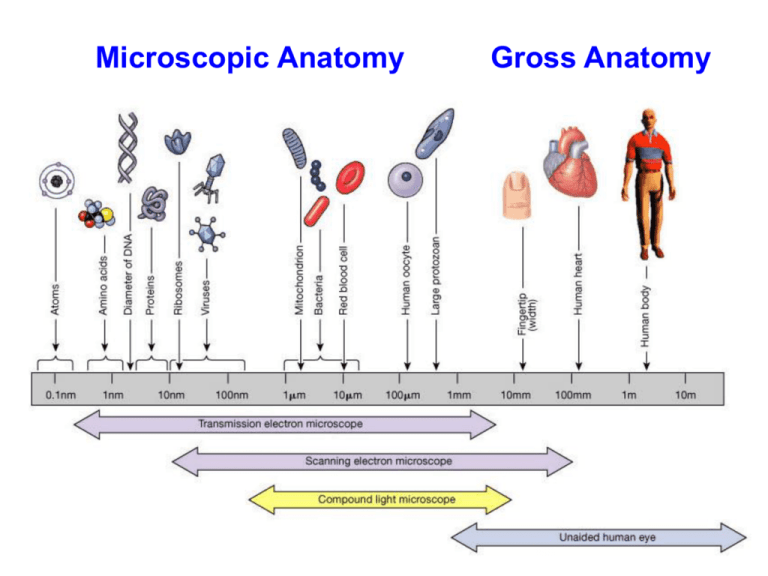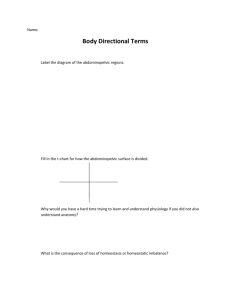1. Introduction to Anatomy
advertisement

Microscopic Anatomy Gross Anatomy Levels of Organization in Human Anatomy Organ Systems of the Body Anatomical Landmarks Selected anatomical regions and commonly used “layperson’s” terminology. Anatomical Landmarks Common Term 1. Cranial Skull 2. Cervical Neck 3. Acromial Shoulder 4. Thoracic Chest 5. Abdominal Belly 6. Gluteal Buttock 7. Inguinal Groin 8. Axillary Armpit 9. Brachial Arm 10. Olecranon / Antecubital Elbow (back) / Fossa (front) 11. Antebrachium Forearm 12. Carpal Wrist 13. Manual Hand 14. Digits (Phalanges) Fingers 15. Femoral Thigh 16. Patellar Knee (front) 17. Popliteal Back of knee 18. Crural Leg (front) 19. Sural Calf (back) 20. Tarsal Ankle Abdominopelvic Quadrants and Regions Sectional Planes Sectional Anatomy Three sectional planes 1. Frontal (Coronal) plane Longitudinal 2. Sagittal plane (mid- and para-) 3. Transverse (Horizontal) plane Body Cavities Posterior (Dorsal) Anterior (Ventral) Sectional View What kind of sectional view (plane) could you call the diagram above? Dorsal Body Cavity 1. Cranial Cavity Contains the brain and CSF. Protects this delicate tissue. 2. Spinal Cavity Contains the spinal cord and CSF. Protects this delicate tissue. Ventral Body Cavity 1. Thoracic Cavity Contains: a) Plural cavities (lungs inside). b) Mediastinum i) Pericardial cavity (heart). 2. Abdominopelvic Cavity Contains: stomach, intestines, gallbladder, liver, spleen, bladder, reproductive organs. Mediastinum Contains: Heart, thymus, trachea, esophagus, vessels (aorta), nerves. Serous Membranes - line ventral body cavities, has 2 portions: Visceral Parietal A. Pleura - membrane lining the pleural cavities. B. Pericardium - lines the pericardial cavity. The Abdominopelvic cavity contains the Peritoneal cavity Peritoneum - lines the peritoneal cavity (this is inside the abdominal cavity). Mesenteries - support and stabilize the digestive organs in abdominal cavity. Directional References Practice using the terms listed in reference to the Various organs and structures within the body. Example of relative position and orientation of a scan for clinical purposes. Can you identify the structures shown below?








